This Week in Petroleum History: May 6 – 12
May 7, 1920 – Halliburton founds Well Cementing Company in Oklahoma –
As mid-continent oil and gas discoveries continued, Erle Palmer Halliburton founded the Halliburton Company as an oilfield well service and cementing company. The Wilson, Oklahoma, venture succeeded his New Method Oil Cementing Company, established a year earlier during the Burkburnett oil boom in North Texas.
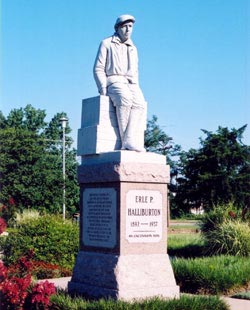
An Erle P. Halliburton statue was dedicated in 1993 in Duncan, Oklahoma.
In 1922, Halliburton patented an innovative “jet-cement” mixer that increased the speed and quality of the mixing process. By the end of the year, 17 Halliburton trucks were cementing wells in Texas, Oklahoma, Louisiana, and Arkansas. Cement injection protects the well casing, seals off water formations from the oil, and minimizes the danger of blowouts.
The company introduced cement pumps powered by truck motors (instead of steam from the rig boiler) and a device that allowed testing of a formation without setting casing. Halliburton was the first to offer self-contained cementing units operating under their own power. More advances in cementing technology followed.
Learn more in Halliburton cements Wells.
May 8, 1918 – Shreveport Gassers go Extra Innings
As baseball became America’s favorite pastime, the Texas League’s Shreveport Gassers played 20 innings against the Fort Worth Panthers before the game was declared a tie. The Gassers were just one of many oilfield-related teams in the National Association of Professional Baseball Leagues, today known as Minor League Baseball.
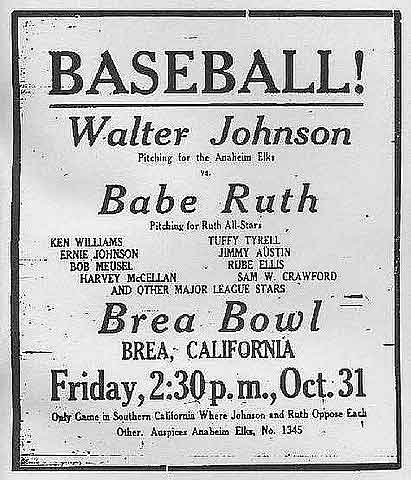
Former Olinda Oil Wells pitcher Walter Johnson joined Babe Ruth for a 1924 exhibition game at Brea, California.
At the time, the leagues’ 96 teams included the Okmulgee Drillers, the Tulsa Oilers, the Independence Producers, the Beaumont Exporters, the Corsicana Oil Citys, the Wichita Falls Spudders, and the Iola Gasbags. In Oklahoma oilfields, the Okmulgee Drillers for the first time in baseball history had two players who combined to hit 100 home runs in a single season of 160 games.
Learn more in Oilfields of Dreams.
May 8, 1920 – Burbank field discovered in Oklahoma
Drilling for natural gas 20 miles east of Ponca City, Oklahoma, the Kay County Gas Company’s Bertha Hickman No. 1 well revealed a giant oilfield. Marland Oil & Refining Company assumed control of the discovery well, which produced 150 barrels of oil a day from a depth of about 3,000 feet. The Burbank field would extend over 33 square miles, mostly in Osage County, and produce between 20 million barrels and 31 million barrels annually for the next four years.
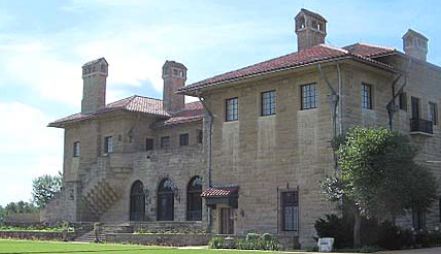
E.W. Marland in 1928 built his Ponca City mansion, now a museum. Fellow Oklahoman Will Rogers was a frequent guest.
With Oklahoma production booming since the Red Fork Gusher of 1901, independent producers agreed to using 10-acre well spacing for oil conservation purposes. Ernest W. Marland’s company also applied new seismographic technologies to discover the Tonkawa oilfield. Learn more about the Oklahoma governor (1935 to 1939) by visiting the Marland Estate in Ponca City.
May 9, 1863 – Confederate Cavalry raids Oilfield
A brigade of Confederate cavalry attacked a thriving oil town near the Ohio River in what would soon become West Virginia. Confederate Gen. William “Grumble” Jones led the cavalry attack on Burning Springs oilfield storage facilities containing thousands of barrels of oil.
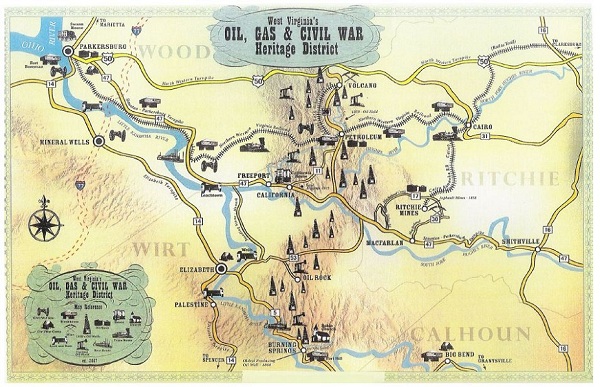
Rebels attacked the Burning Springs oilfield on the banks of the Little Kanawha River, just a few miles southeast of Parkersburg and the Ohio River. Heritage district map courtesy Oil & Gas Museum, Parkersburg, West Virginia.
The Confederate raid’s destruction and fire along the Kanawha River marked the first time an oilfield was targeted in war. About 1,300 Confederate troopers raided Burning Springs, destroying cable-tool drilling rigs and 150,000 barrels of oil.
Economic growth created by the early petroleum industry prior to the Civil War helped lead to statehood for West Virginia in June 1863. Almost a century earlier, George Washington had acquired 250 acres in the region because it contained natural oil seeps.
Learn more in Confederates attack Oilfield.
May 11, 1880 – Dresser patents Oil Well Device
Solomon R. Dresser of Bradford, Pennsylvania, patented a rubber “packer” for sealing downhole pressure in wells. The technology behind the patent (no. 227419) helped confine gas, “which enters the well from the lower rocks and utilize its force or pressure to expel the oil from the well.”
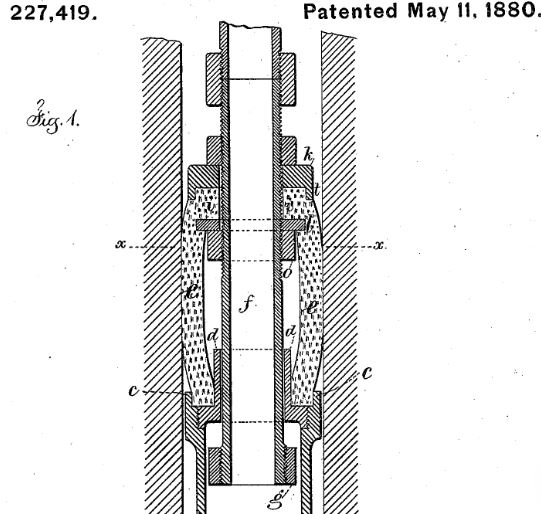
Detail from Solomon R. Dresser 1880 patent for a rubber “packer” to seal downhole pressure in wells.
With the success of his Dresser Cap Packer in the Bradford oilfield, the inventor founded the S.R. Dresser Manufacturing Company in 1885. Within one year he would patent a widely adopted pipeline coupling method using rubber for tight seals, which permitted long-range transmission of natural gas.
After expanding into manufacturing oilfield pumps, engines and compressors, Dresser’s company went public in 1928, moving its headquarters to Dallas in 1950. Dresser Industries merged with oilfield supply rival Halliburton for about $7.7 billion in stock in 1998.
May 12, 2007 – Two Oil Museums open in Oklahoma
ConocoPhillips opened petroleum museums in Ponca City and Bartlesville as part of the 2007 Oklahoma statehood centennial celebrations.
Exhibits at the Conoco Museum In Ponca City educate visitors about the company, which began in Utah as Continental Oil Company, a distributor of coal, grease, and kerosene. Continental Oil merged with Ponca City-based Marland Oil Company in 1929; Conoco merged with Phillips Petroleum Company of Bartlesville in 2002.

Conoco, founded in 1875 as the Continental Oil and Transportation Company, delivered kerosene to retail stores in Ogden, Utah. A circa 1880s tank wagon now welcomes visitors to the Conoco Museum. Photo by Bruce Wells.
Frank and L.E. Phillips drilled 81 wells without a “dry hole” prior to establishing their company in 1917. The Phillips Petroleum Company Museum preserves the their oil patch legacy, the history of high-octane gasoline, and the company’s thousands of U.S. patents — including for plastic products like Marlex. Frank Phillips served as president until 1938.
Learn more in ConocoPhillips Petroleum Museums.
Recommended Reading: Erle P. Halliburton, Genius with Cement (1959); Oil in Oklahoma
(1976); Textile League Baseball: South Carolina’s Mill Teams, 1880-1955
(2004); The Civil War and Northwestern Virginia
(2004); Conoco: 125 Years of Energy
(2000); Phillips, The First 66 Years
(1983). Your Amazon purchase benefits the American Oil & Gas Historical Society. As an Amazon Associate, AOGHS earns a commission from qualifying purchases.
_______________________
The American Oil & Gas Historical Society preserves U.S. petroleum history. Become an AOGHS annual supporting member and help maintain this energy education website and expand historical research. Contact bawells@aoghs.org. Copyright © 2024 Bruce A. Wells. All rights reserved.


